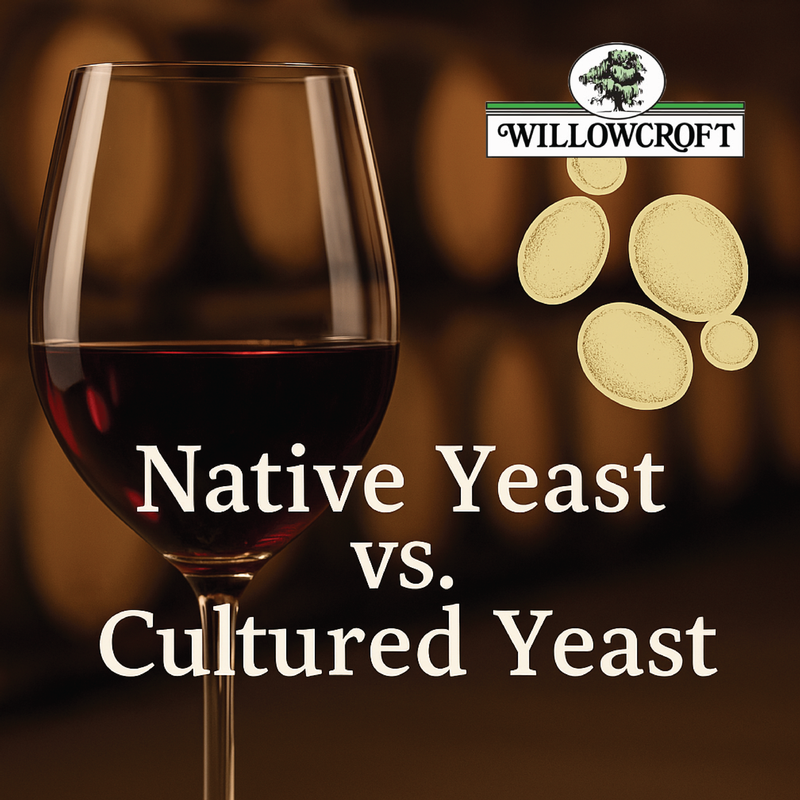Native Yeast vs. Cultured Yeast: Who’s Fermenting Your Wine?

When you think of what gives wine its flavor, you might picture grapes, barrels, or even the soil beneath the vines. But one of the most powerful forces shaping your wine’s personality is microscopic: yeast.
Yeast is what turns grape juice into wine. Without it, there’s no fermentation—no alcohol, no aroma development, and no complexity. But not all yeast is the same. Winemakers must choose between using native (wild) yeast or cultured (commercial) strains, and that decision can have a significant impact on the final product.
At Willowcroft, we carefully select yeast for each wine, balancing the expression of place with fermentation stability. So what’s the difference between native and cultured yeast—and why does it matter?
Yeast’s job in winemaking is to consume the sugars in grape juice and convert them into alcohol, carbon dioxide, and hundreds of aromatic compounds that contribute to flavor, texture, and aroma.
The superstar of the fermentation world is a species called Saccharomyces cerevisiae. It’s found all over vineyards, cellars, and winery equipment—and is the dominant player in both native and cultured fermentations.
But how that yeast gets into the fermentation tank is where things diverge.
Native yeast refers to the wild strains naturally present on grape skins, in the vineyard environment, and in the winery itself. When a winemaker allows fermentation to occur spontaneously, without adding commercial yeast, these ambient strains kick off the process.
Benefits of native yeast:
- Terroir expression: Native yeasts are unique to each vineyard and vintage, potentially offering more distinctiveness and complexity.
- Minimal intervention: Wild fermentation aligns with low-intervention, sustainable winemaking philosophies.
- Flavor nuance: A variety of yeast strains can contribute layers of aroma and mouthfeel, especially early in fermentation.
Risks of native yeast:
- Unpredictability: Some wild strains may start fermentation but struggle to finish it.
- Higher chance of spoilage: If undesirable microbes take over, it can lead to off-flavors or stuck fermentations.
- Longer fermentation time: Native ferments are typically slower and require more monitoring.
In cooler climates or low-sugar grape musts, native fermentation can be an elegant choice. But in warmer, more humid regions like Virginia, where microbial pressure is higher, the risks must be carefully managed.
Cultured yeasts are laboratory-selected strains of Saccharomyces cerevisiae developed for consistency, efficiency, and targeted winemaking outcomes. They’re available in a wide array of strains—each suited to different grape varieties, fermentation temperatures, and desired wine styles.
Commonly used strains include:
- EC-1118: Excellent for sparkling wine and high-alcohol fermentations
- D47: Often used in whites like Chardonnay for fuller mouthfeel and citrus notes
- RC212: A go-to for Pinot Noir and other delicate reds to enhance berry flavors
Benefits of cultured yeast:
- Predictable results: Reliable fermentation from start to finish
- Tailored performance: Choose a strain to match the wine’s style, structure, and flavor goals
- Lower risk of spoilage: Outcompetes unwanted wild microbes
Limitations:
- Less spontaneity: You sacrifice some of the unknown character and potential complexity of a native ferment
- Less expression of place: Commercial yeast may dominate the flavor profile instead of the vineyard
There’s no one-size-fits-all answer. Some winemakers swear by native fermentation for its authenticity. Others rely on cultured yeast for precision and peace of mind.
At Willowcroft, we recognize the value of both approaches. For certain small-batch or expressive wines, native fermentations can shine. For other wines—particularly those with delicate balance or specific style goals—cultured strains offer important control and consistency.
Ultimately, the best yeast is the one that lets the grape, the vintage, and the vineyard speak most clearly.
Yeast may be invisible, but its impact is undeniable. Whether wild or cultured, the tiny organisms doing the heavy lifting during fermentation help craft every swirl, sniff, and sip.
So next time you enjoy a Willowcroft wine, know that behind the scenes—at a cellular level—a carefully chosen yeast helped shape that wine’s unique story.

